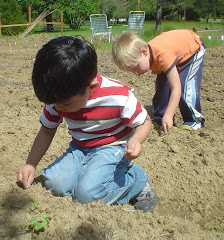Planting peas in a greenhouse for early-harvests.
 |
| Pea-seedlings - a promise of delicious, sweet nibbles to come! |
If you have a greenhouse, and live in a similar climate as the Sharing Gardens (we're in zone 8a, according to the
USDA zone map)
you can start your seeds in pots right at New Year's, and then
transplant them into greenhouse beds by mid-February. Seeds started in
pots in mid-February can be transplanted to
outside beds in
March. If previous years are any indication, by starting our first batch
of seeds now (New Year's) we'll be eating peas by late March and on
into April - at which point the peas we plant
outside the greenhouse will begin producing and carry us through May or June!
You'll need:
- Seeds (link to article on saving your own pea-seeds)
- Soil
- 4" pots (6" deep) - the deeper pots give more time before plants become root-bound.
Fill pots to within a half-inch of the top. Gently tamp down soil so it doesn't settle too far when you water it.
Poke
two seeds, in opposite corners, about the depth of one knuckle (3/4" or
so).
That's two seeds per pot. This gives each plant enough soil to
germinate and grow to
several inches in height before you transplant. Cover the seeds with
soil so they're not exposed to sun. Water them gently. Do not
over-water. Seedlings can rot if soil is too damp.
 |
| Note: Since having written this article, we have now shifted to planting two seeds per pot but do not have photos to reflect this. |
Keep the potted seeds protected from marauding slugs
by putting them up on a table, or putting a milk-carton collar around
them.
(Link to post on Re-Purposing Things - including milk-cartons as collars)
.
If you're planting in January, you'll need a greenhouse to protect them
and keep soil in pots warm enough for germination. If you wait until
mid-February, pots can be outside in a sunny place, protected from north
winds.
When they are
at least
6", and no longer than 12", you can put them in your garden, or greenhouse beds. Best to
wait until their root-systems are quite dense in the pots -- almost
"root-bound". They will be easier to transplant without damaging the
plants. On the other-hand, if you wait until the stems are too long, you
risk breaking stems during transplanting so it's a matter of finding
the right balance.
 |
| Pea-seedlings in pots. |
Transplanting: Plant each 4" pot (with its two seedlings) about 8"- 10" apart with bamboo stakes or
other climbing trellis in between each clump of starts. Pea-plants are
not typically transplanted but sowed directly in place. They are very
susceptible to shock so be gentle with the roots and stems. Best to have
your trellis in place
before you transplant so you don't injure
roots driving in the stakes. If slugs are a big issue in your area,
planting them in the milk-carton collars can make a big difference. We
also typically sprinkle about a teaspoon of iron-phosphate ("Sluggo")
around each bunch of plants. This is an organically-approved way of
dealing with slug/snail infestations in your garden.
(LINK to article about iron phosphate).
The plants will
go through a little stress from transplanting but once they acclimatize
to their new environment they'll be well along the way to yielding a
bounteous and long-term harvest!
 |
| Good idea to have trellis in place before you transplant peas (so you're less likely to damage roots). |
 |
| John and Llyn transplanting pea-seedlings outside, in early to mid-spring. |
 |
| Sara picking peas in the greenhouse in April. |
 |
| Pea-vines
headed for the compost pile. Peas, being legumes are able to add
nitrogen to your soil through a symbiotic relationship with organisms
that grow on their roots. This will help improve your soil, particularly
if you leave the roots in the ground when you cut down the "greens" to
add to your compost pile. |
 |
| Growing food together, grows community too! |













































No comments:
Post a Comment